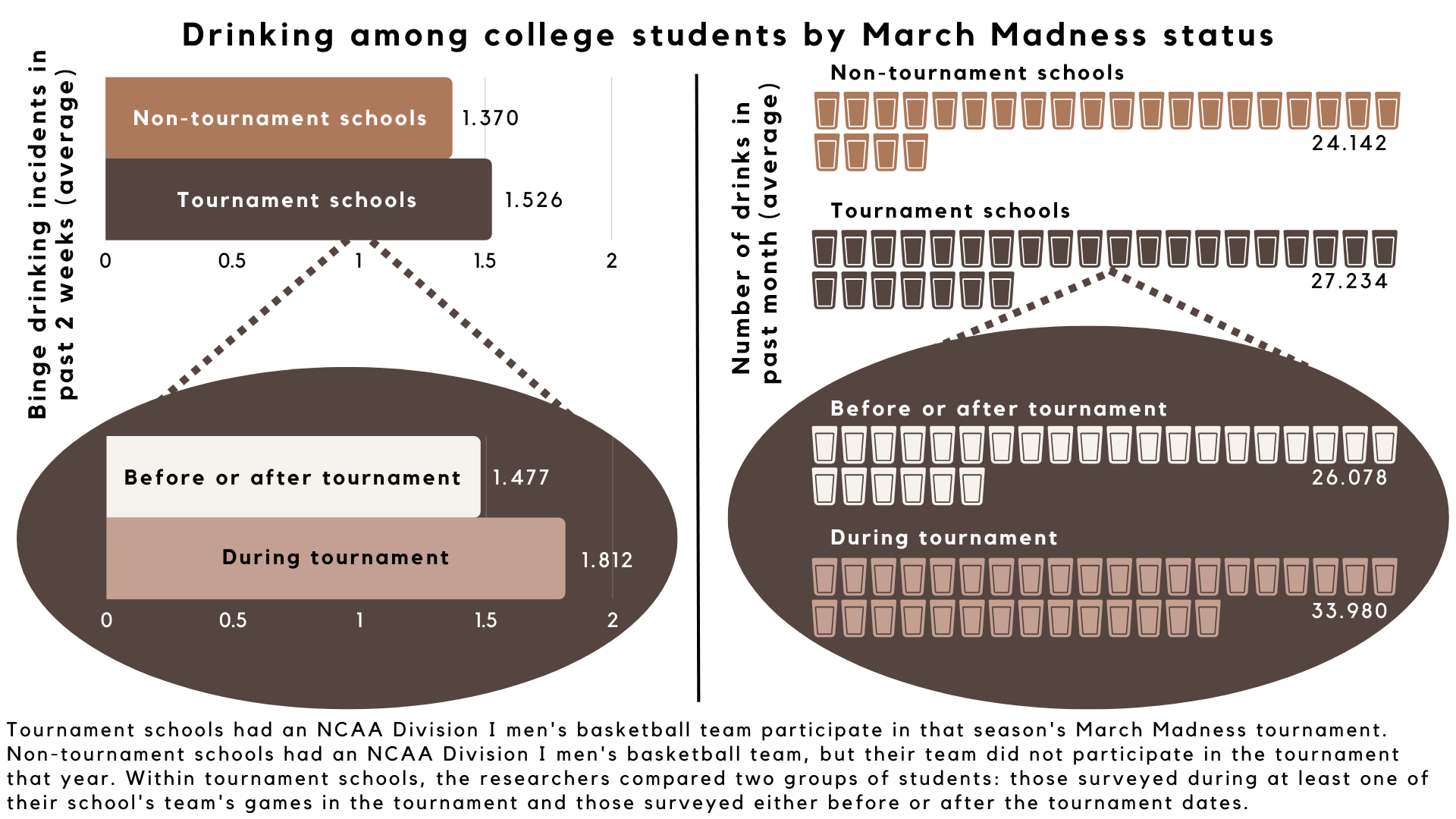Drinking alcohol is common among college students, with the majority of students reporting past-month alcohol use and one in three engaging in binge drinking. Research suggests that college game days and the success of the school’s sports teams are both associated with increased alcohol use. March Madness, which refers to the (U.S.) National Collegiate Athletic Association (NCAA) Division I men’s and women’s basketball tournaments, is arguably the most popular college sporting event in the United States. This week, The DRAM reviews a study by Dustin R. White and colleagues that estimated the influence of the men’s March Madness tournament on student alcohol consumption.
What was the research question?
How does a school’s participation in the men’s March Madness tournament influence student alcohol consumption?
What did the researchers do?
Almost 26,000 full-time college students at schools with an NCAA Division I men’s basketball team were surveyed as part of the Harvard School of Public Health College Alcohol Study in 1993, 1997, 1999, and 2001. The drinking measures of interest were binge drinking incidents in the past two weeks, alcoholic drinks consumed in the past month, drunk driving occasions in the past month, and times riding in a car with a drunk driver in the past month. Using a difference-in-differences analysis, the researchers examined school differences (whether a respondent attended a tournament school in that year) and time differences (whether a respondent’s survey covers the time period for the tournament).
What did they find?
Students at tournament schools reported more binge drinking incidents and alcoholic drinks, compared to students at non-tournament schools (see Figure). These increases in binge drinking and overall alcohol consumption were positively associated with how deep into the single-elimination tournament the school’s basketball team advanced, and males experienced greater increases than females. Students at tournament schools were also more likely to report drunk driving and riding in a car with a drunk driver. Among tournament schools, students surveyed during the tournament engaged in more binge drinking and total drinking than students surveyed before or after the tournament dates (see Figure).

Figure. Average number of binge drinking incidents in the past 2 weeks (left) and average number of drinks in the past month (right) among college students by their school’s March Madness tournament status (tournament vs. non-tournament schools; students at tournament schools surveyed during the tournament vs. students at tournament schools surveyed before or after the tournament dates). Click image to enlarge.
Why do these findings matter?
During March Madness, drinking increases among students at participating schools, especially among males as the school’s basketball team advances further in the tournament. College administrators should implement targeted interventions throughout basketball season and leading up to the tournaments, including providing education about perceived drinking norms and promoting harm reduction messages. Tournament schools should also consider increasing law enforcement related to underage drinking and drunk driving, and encourage students to use rideshare services if they have been drinking.
Every study has limitations. What are the limitations in this study?
The researchers did not know the exact dates students completed their surveys, only the date it was processed by survey administrators. They accounted for a 4-week lag time between survey completion and processing to try to address this limitation, but the exact period of time for which each student reported their drinking measures cannot be confirmed. In addition, this study is based on self-reports, so recall bias and/or social desirability may have had an effect on survey responses and the study’s findings.
For more information:
The National Institute on Alcohol Abuse and Alcoholism has tips and resources for people struggling with problem drinking. For additional drinking self-help tools, please visit our Addiction Resources page.
— Caitlyn Matykiewicz, MPH
What do you think? Please use the comment link below to provide feedback on this article.




